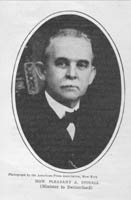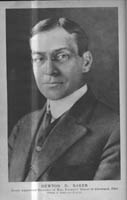Table of Contents
Media Index
CHAPTER 12

Count Johann-Heinrich von Bernstorff (1862-1939) was the German ambassador to the United States until February 1917 and then became the German Ambassador to the Ottoman Empire.
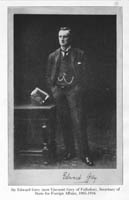
Official photograph of Sir Edward Grey (1862-1933), British Foreign Secretary for the first two years of the Great War.
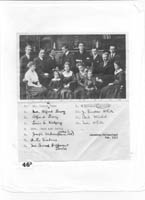
This is a group photograph of the American WPA secretaries and their families who had just left Germany in February 1917, after the United States broke off diplomatic relations with the German Empire. The group traveled to Lausanne where some continued WPA work with the World's Alliance and others transferred to war work with the Allied armies. The individuals in the photograph included: 1) Lewis Dunn; 2) Mrs. Alfred Lowry; 3) Alfred Lowry; 4) Louis Wolferz; 5) Mrs. Lewis Dunn and Betty Dunn; 6) Joseph Wehner; 7) A. R. Siebens; 8) Mrs. Conrad Hoffman and Louise Hoffman (holding the teddy bear); 9) Spencer Kennard; 10) J. Gustav White; 11) Carl Michel; and 12) Mrs. Gustav White. It is interesting that the WPA secretaries were able to bring their wives and daughters with them to Germany in support of their mission. Of the transfers, Wehner was killed in France in 1918.
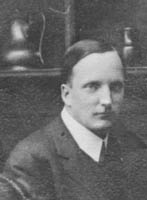
Alfred Lowry, Jr. was an American YMCA WPA Secretary who served Allied POW's in Bavaria during the First World War.
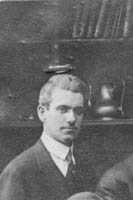
Lewis Dunn was an American YMCA WPA Secretary who served Allied prisoners of war in Germany until February 1917.
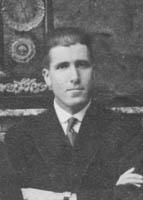
Arthur Siebens was an American YMCA secretary and supported WPA operations in Germany from 1916 to 1917.
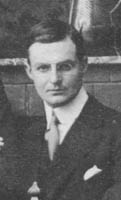
J. Spencer Kennard was an American YMCA WPA Secretary who conducted relief operations for Allied POW's in Germany during World War I.
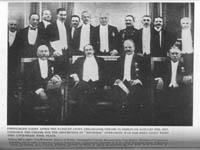
General Friedrich, standing in the German uniform, fourth from the right, was the commander of the Prisoner of War Department in the German Ministry of War during World War I; he posed for this photograph with other guests at a banquet given in honor of Ambassador James W. Gerard, seated second from the left, in January 1917.
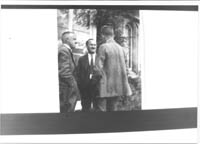
Conrad Hoffman (d. 1958) served as the Senior American YMCA WPA Secretary in Germany during World War I; Hoffman, in the center, is photographed in a conversation.
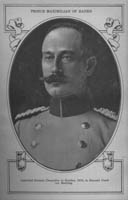
Portrait of Prince Max of Baden (1867-1929); he strongly supported the American YMCA's efforts to establish the WPA Program in Germany and served as the last Chancellor of imperial Germany.
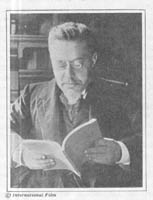
Luis Polo de Bernabe served as the Spanish ambassador to Germany during World War I and represented Allied interests, including American concerns regarding the treatment of prisoners of war, after the United States severed diplomatic relations with the German Empire in February 1917.
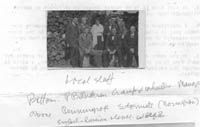
Crawford Wheeler, sitting in the middle of the photograph with the bow tie (next to Paul B. Anderson at the left), volunteered to serve as a WPA Secretary for the American YMCA in Germany during World War I. Before the United States declared war on Germany in April 1917, Wheeler left the empire and worked in Scandinavia preparing neutral YMCA secretaries for WPA work in the Central Power states to replace the departed American Red Triangle workers. He went to Russia in 1917 and worked with Russian soldiers in Moscow and Archangel until 1919.
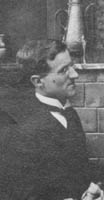
Louis Wolferz was an American YMCA secretary who volunteered to conduct WPA operations for Allied POW's in Germany from 1916 to 1917.
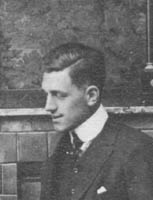
Joseph E. Wehner (d. 1918) was an American YMCA WPA Secretary in Germany from 1916 to 1917; he was killed on the Western Front in 1918.
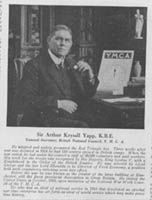
Sir Arthur Yapp (1869-1936), General Secretary of the English National Council of YMCA's, sits at his desk with a fund-raising "clock," which indicated British public support for Association war work efforts.
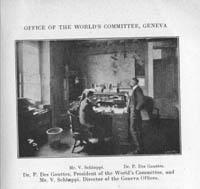
Victor Schlaeppi became the Director of the Geneva office of the World's Alliance of YMCA's in Geneva in 1910 and edited the Messenger to the Prisoners of War during World War I. He is seated at his desk while Dr. Paul Des Gouttes, President of the World's Alliance, stands to the right.

Robert Ewing (1878-1934) supervised WPA operations in England early in the war and became the Senior American YMCA Secretary in Great Britain when the United States declared war on Germany in April 1917.
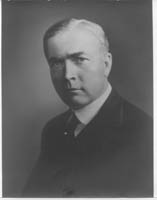
Photograph of John R. Mott (1865-1955); he was appointed General Secretary of the International Committee of the American YMCA in 1915 and General Secretary of the World's Committee of the World's Alliance in 1926.
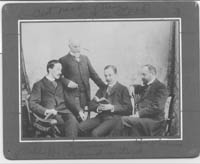
This early photograph shows leaders in the pre-World War I World's Alliance movement. Charles Fermaud, standing, listens to Baron W. von Starck, center, reading a book. Victor Schlaeppi sits on the left while Christian Phildius flanks von Starck on the right.
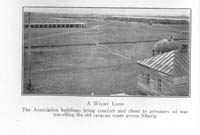
The building with the dome to the right is a YMCA hall established in a POW camp for Central Power prisoners somewhere in Siberia. The prisoners of war lived in the barracks across the parade grounds at the back of the photograph.
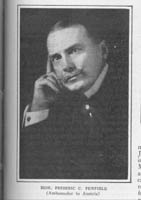
Portrait of Frederic Courtland Penfield (1855-1922), United States ambassador to Austria-Hungary from 1913 to 1917, when the U.S. broke off diplomatic relations with the Dual Monarchy.
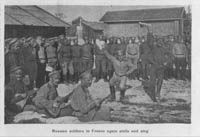
The members of the Russian Legion fighting in France on the Western Front found themselves in a difficult situation after the Bolsheviks signed the Treaty of Brest-Litovsk in March 1918. These Russian troops expected to return home with the Russian withdrawal from the war, but the Allies decided to imprison many of these men. The American YMCA established relief services in these interment camps to improve the inmates' situation. Two Russian soldiers dance while others play music to boost morale in the camp.
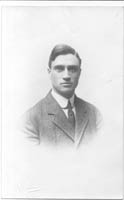
Portrait of Edgar MacNaughten (1882-1933), the American YMCA Senior WPA Secretary in Austria-Hungary from 1916 to 1917; MacNaughton became the Senior American Navy Secretary Overseas in 1918.
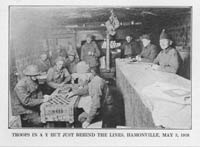
American and French troops unwind in a YMCA hut just behind the front lines at Hamonville, France. Two games of checkers unfold while other soldiers enjoy a hot drink served by the Red Triangle workers at the counter. Much of the furniture is of makeshift construction, using material available at the front and the hut is heated by a stove in the back of the room. Every ready for sports, a pair of boxing gloves hand from the roof and a catcher's mitt and baseball sit in the corner.
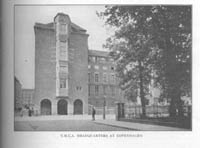
This photograph shows the exterior of the Danish YMCA headquarters in Copenhagen. The Danish Association provided critical support for the War Prisoners' Aid program for Allied POW's in Germany.
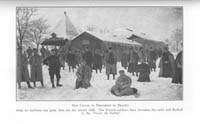
French soldiers sit and stand outside of a Foyer du Soldat somewhere in France after a heavy snow fall. These men preferred to spend their leisure time at the YMCA instead of pursuing a variety of social vices available to soldiers in wartime France.
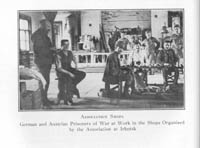
German and Austro-Hungarian POW's work in a shop organized and equipped by the American YMCA at a prison camp in Irkutsk in Siberia. The men working at the table are tailors while carpenters labor in the background.
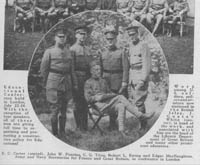
Five American YMCA secretaries pose for a photograph during the Educational Conference held in London in July 1918. Two of these men had extensive WPA experience. Robert Ewing, standing in the middle right, was a member of the original Flying Squadron sent to Europe in 1915. He became the Senior WPA Secretary in Britain until 1917 when he transferred to supervise the AEF-YMCA Program in Britain. Edgar MacNaughten, standing to the extreme right, was the Senior American WPA Secretary in Austria-Hungary from 1915 to October 1917. Before the United States declared war against the Dual Monarchy, he went to Switzerland to take over the distribution of Russian books to German prison camps. In 1918, MacNaughten became the Senior American Navy Secretary Overseas, working in Britain. Three other American YMCA secretaries are also featured in this photograph: E. C. Carter is seated and standing to the left are J. W. Pontius and C. G. Titus.
